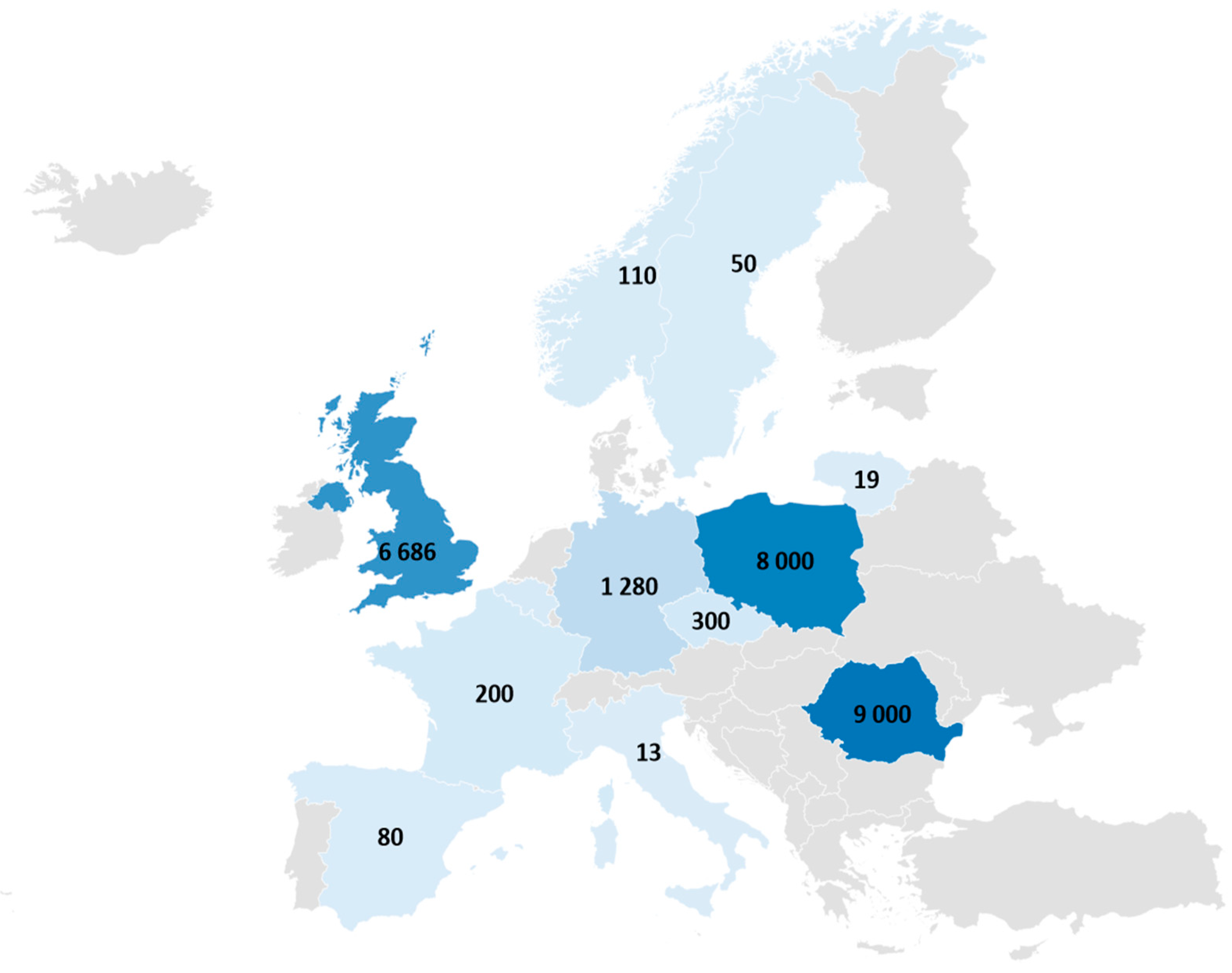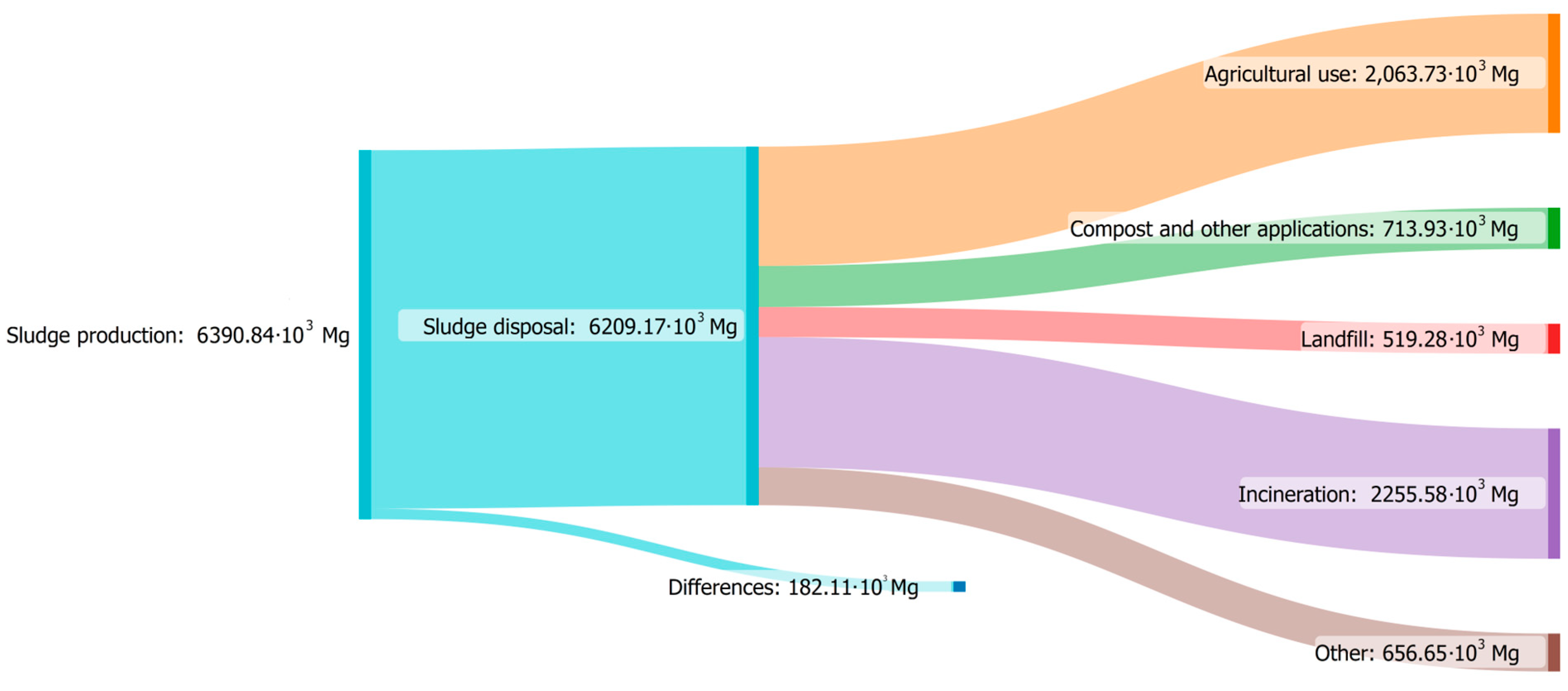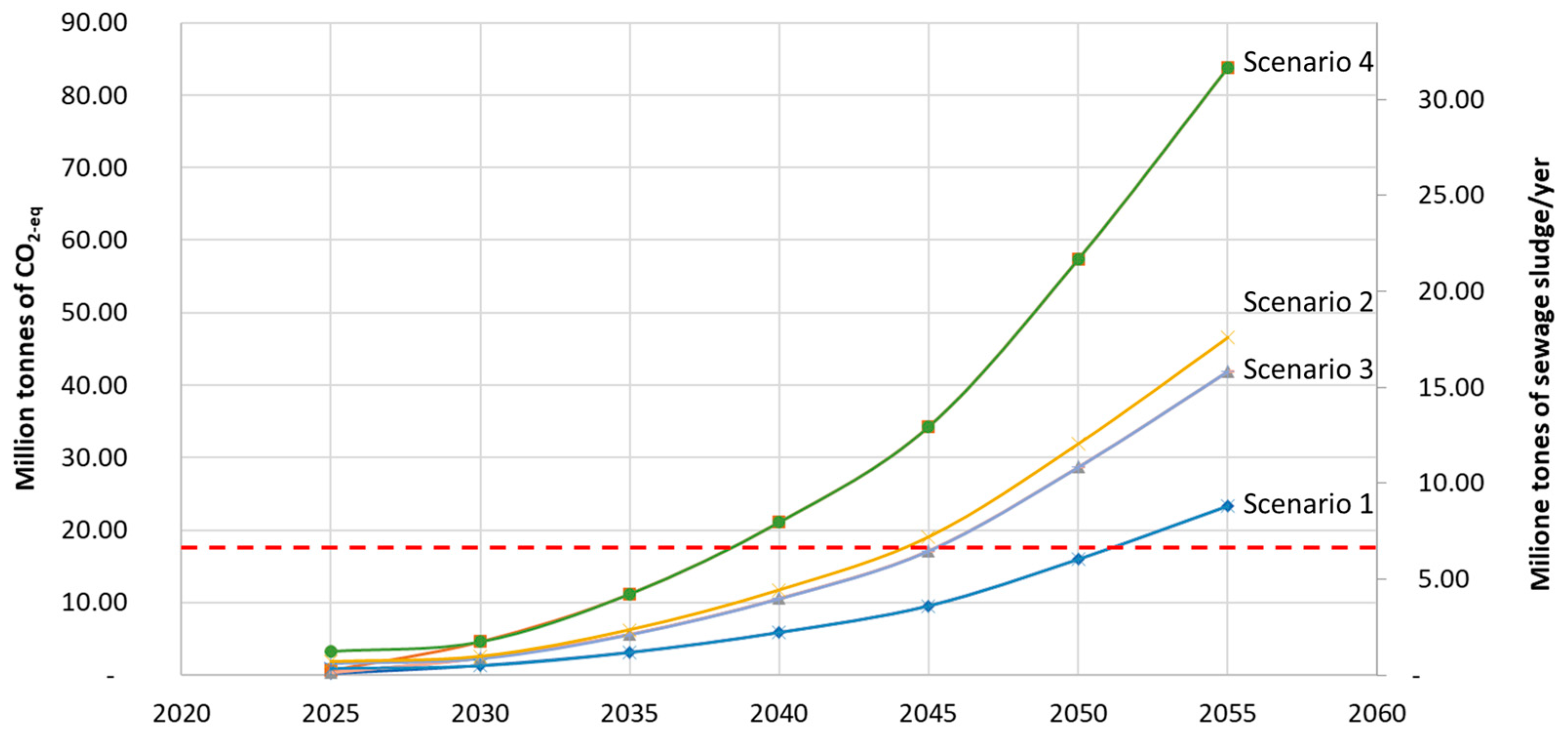Perspectives of Using Sewage Sludge Char in CO2 Sequestration on Degraded and Brownfield Sites
Abstract
1. Introduction
2. Sources of Soil Contamination
3. Degraded and Brownfield Sites in Europe
4. The Prospect of Using Biomass Waste in CO2 Sequestration on Degraded and Brownfield Sites
- Sequestration will only be carried out on brownfield sites (25,000 km2), with the lowest assumed soil carbon sequestration potential of 0.4 t C ha−1 yr−1.
- Sequestration will be pursued on both brownfield and degraded land (45,000 km2), with the lowest assumed soil carbon sequestration potential of 0.4 t C ha−1 yr−1.
- Sequestration will only occur on brownfield sites (25,000 km2), with the highest assumed soil carbon sequestration potential of 0.8 t C ha−1 yr−1.
- Sequestration will take place on both brownfield and degraded land (45,000 km2), with the highest assumed soil carbon sequestration potential of 0.8 t C ha−1 yr−1.
5. Conclusions
Author Contributions
Funding
Data Availability Statement
Acknowledgments
Conflicts of Interest
References
- Rajaganapathy, V.; Xavier, F.; Sreekumar, D.; Mandal, P.K. Heavy Metal Contamination in Soil, Water and Fodder and Their Presence in Livestock and Products: A Review. J. Environ. Sci. Technol. 2011, 4, 234–249. [Google Scholar] [CrossRef]
- Iram, S.; Ahmad, I.; Stuben, D. Analysis of Mines and Contaminated Agricultural Soil Samples for Fungal Diversity and Tolerance to Heavy Metals. Pak. J. Bot. 2009, 41, 885–895. [Google Scholar]
- Pieszko, C.; Sajdak, M. Chemometric Analysis of Heavy Metals Coexistence in Different Plant Matrices in the Upper Silesian Industrial District. Ecol. Chem. Eng. S 2013, 20, 79–91. [Google Scholar] [CrossRef]
- Sajdak, M.; Pieszko, C. Chemometric Analysis of Heavy Metal Content for Various Environmental Matrices in Terms of Their Use in Biomass Thermal Processing. Open Chem. 2012, 10, 1696–1706. [Google Scholar] [CrossRef]
- Siddiqua, A.; Hahladakis, J.N.; Al-Attiya, W.A.K.A. An Overview of the Environmental Pollution and Health Effects Associated with Waste Landfilling and Open Dumping. Environ. Sci. Pollut. Res. 2022, 29, 58514–58536. [Google Scholar] [CrossRef]
- Austin, G. Case Study and Sustainability Assessment of Bo01, Malmo, Sweden. J. Green Build. 2013, 8, 34–50. [Google Scholar] [CrossRef]
- Bibri, S.E. The Eco-City and Its Core Environmental Dimension of Sustainability: Green Energy Technologies and Their Integration with Data-Driven Smart Solutions. Energy Inform. 2020, 3, 1–26. [Google Scholar] [CrossRef]
- Shukla, L.; Jain, N. A Review on Soil Heavy Metals Contamination: Effects, Sources and Remedies. Appl. Ecol. Environ. Sci. 2022, 10, 15–18. [Google Scholar] [CrossRef]
- Hou, D.; O’Connor, D.; Igalavithana, A.D.; Alessi, D.S.; Luo, J.; Tsang, D.C.W.; Sparks, D.L.; Yamauchi, Y.; Rinklebe, J.; Ok, Y.S. Metal Contamination and Bioremediation of Agricultural Soils for Food Safety and Sustainability. Nature Rev. Earth Environ. 2020, 1, 366–381. [Google Scholar] [CrossRef]
- Orjales, I.; Herrero-Latorre, C.; Miranda, M.; Rey-Crespo, F.; Rodríguez-Bermúdez, R.; López-Alonso, M. Evaluation of Trace Element Status of Organic Dairy Cattle. Animal 2018, 12, 1296–1305. [Google Scholar] [CrossRef]
- Pilarczyk, R.; Wójcik, J.; Czerniak, P.; Sablik, P.; Pilarczyk, B.; Tomza-Marciniak, A. Concentrations of Toxic Heavy Metals and Trace Elements in Raw Milk of Simmental and Holstein-Friesian Cows from Organic Farm. Environ. Monit. Assess. 2013, 185, 8383–8392. [Google Scholar] [CrossRef]
- Overview—Waste—Eurostat. Available online: https://ec.europa.eu/eurostat/web/waste (accessed on 25 March 2023).
- de Paye, H.S.; de Mello, J.W.V.; Abrahão, W.A.P.; Filho, E.I.F.; Dias, L.C.P.; Castro, M.L.O.; de Melo, S.B.; França, M.M. Valores de Referência de Qualidade Para Metais Pesados Em Solos No Estado Do Espírito Santo. Rev. Bras. Cienc. Solo 2010, 34, 2041–2051. [Google Scholar] [CrossRef]
- Guvenç, N.; Alagha, O.; Tuncel, G. Investigation of Soil Multi-Element Composition in Antalya, Turkey. Environ. Int. 2003, 29, 631–640. [Google Scholar] [CrossRef] [PubMed]
- Myllymäki, S.A.; Haavisto, T.E.; Brokken, L.J.S.; Viluksela, M.; Toppari, J.; Paranko, J. In Utero and Lactational Exposure to TCDD; Steroidogenic Outcomes Differ Male Female Rat Pups. Toxicol. Sci. 2005, 88, 534–544. [Google Scholar] [CrossRef] [PubMed]
- Mutoh, J.; Taketoh, J.; Okamura, K.; Kagawa, T.; Ishida, T.; Ishii, Y.; Yamada, H. Fetal Pituitary Gonadotropin as an Initial Target of Dioxin in Its Impairment of Cholesterol Transportation and Steroidogenesis in Rats. Endocrinology 2006, 147, 927–936. [Google Scholar] [CrossRef]
- Badawi, A.F.; Cavalieri, E.L.; Rogan, E.G. Effect of Chlorinated Hydrocarbons on Expression of Cytochrome P450 1A1, 1A2 and 1B1 and 2- and 4-Hydroxylation of 17β-Estradiol in Female Sprague–Dawley Rats. Carcinogenesis 2000, 21, 1593–1599. [Google Scholar] [CrossRef]
- Ravindra, K.; Sokhi, R.; Van Grieken, R. Atmospheric Polycyclic Aromatic Hydrocarbons: Source Attribution, Emission Factors and Regulation. Atmos. Environ. 2008, 42, 2895–2921. [Google Scholar] [CrossRef]
- Tobiszewski, M.; Namieśnik, J. PAH Diagnostic Ratios for the Identification of Pollution Emission Sources. Environ. Pollut. 2012, 162, 110–119. [Google Scholar] [CrossRef]
- Zhang, X.L.; Tao, S.; Liu, W.X.; Yang, Y.; Zuo, Q.; Liu, S.Z. Source Diagnostics of Polycyclic Aromatic Hydrocarbons Based on Species Ratios: A Multimedia Approach. Environ. Sci. Technol. 2005, 39, 9109–9114. [Google Scholar] [CrossRef]
- Yang, L. Phytoremediation: An Ecotechnology for Treating Contaminated Sites. Pract. Period. Hazard. Toxic. Radioact. Waste Manag. 2008, 12, 290–298. [Google Scholar] [CrossRef]
- Behera, K.K. Phytoremediation, Transgenic Plants and Microbes. In Sustainable Agriculture Reviews; Springer: Berlin/Heidelberg, Germany, 2014; pp. 65–85. [Google Scholar] [CrossRef]
- McIntyre, T. Phytoremediation of Heavy Metals from Soils. Adv. Biochem. Eng. Biotechnol. 2003, 78, 97–123. [Google Scholar] [CrossRef] [PubMed]
- Methods of Assessing Risk to Health from Exposure to Hazards Released from Waste Landfills. Available online: https://apps.who.int/iris/handle/10665/108362 (accessed on 25 March 2023).
- Elliott, P.; Richardson, S.; Abellan, J.J.; Thomson, A.; De Hoogh, C.; Jarup, L.; Briggs, D.J. Geographic Density of Landfill Sites and Risk of Congenital Anomalies in England. Occup. Environ. Med. 2009, 66, 81–89. [Google Scholar] [CrossRef] [PubMed]
- Rushton, L. Health Hazards and Waste Management. Br. Med. Bull. 2003, 68, 183–197. [Google Scholar] [CrossRef] [PubMed]
- Panagos, P.; Hiederer, R.; Van Liedekerke, M.; Bampa, F. Estimating Soil Organic Carbon in Europe Based on Data Collected through an European Network. Ecol. Indic. 2013, 24, 439–450. [Google Scholar] [CrossRef]
- Panagos, P.; Van Liedekerke, M.; Jones, A.; Montanarella, L. European Soil Data Centre: Response to European Policy Support and Public Data Requirements. Land. Use Policy 2012, 29, 329–338. [Google Scholar] [CrossRef]
- Toth, G.; Jones, A.; Montanarella, L.; Alewell, C.; Ballabio, C.; Carre, F.; De, B.D.; Guicharnaud, R.A.; Gardi, C.; Hermann, T.; et al. LUCAS Topoil Survey—Methodology, Data and Results; Publications Office of the European Union: Brussels, Belgium, 2013. [Google Scholar] [CrossRef]
- Lugato, E.; Bampa, F.; Panagos, P.; Montanarella, L.; Jones, A. Potential Carbon Sequestration of European Arable Soils Estimated by Modelling a Comprehensive Set of Management Practices. Glob. Chang. Biol. 2014, 20, 3557–3567. [Google Scholar] [CrossRef]
- Lugato, E.; Panagos, P.; Bampa, F.; Jones, A.; Montanarella, L. A New Baseline of Organic Carbon Stock in European Agricultural Soils Using a Modelling Approach. Glob. Chang. Biol. 2014, 20, 313–326. [Google Scholar] [CrossRef]
- Lugato, E.; Paustian, K.; Panagos, P.; Jones, A.; Borrelli, P. Quantifying the Erosion Effect on Current Carbon Budget of European Agricultural Soils at High Spatial Resolution. Glob. Chang. Biol. 2016, 22, 1976–1984. [Google Scholar] [CrossRef]
- Panagos, P.; Van Liedekerke, M.; Yigini, Y.; Montanarella, L. Contaminated Sites in Europe: Review of the Current Situation Based on Data Collected through a European Network. J. Environ. Public Health 2013, 2013, 158764. [Google Scholar] [CrossRef]
- Sajdak, M.; Majewski, A.; Di Gruttola, F.; Gałko, G.; Misztal, E.; Rejdak, M.; Hornung, A.; Ouadi, M. Evaluation of the Feasibility of Using TCR-Derived Chars from Selected Biomass Wastes and MSW Fractions in CO2 Sequestration on Degraded and Post-Industrial Areas. Energies 2023, 16, 2964. [Google Scholar] [CrossRef]
- Franz, M.; Pahlen, G.; Nathanail, P.; Okuniek, N.; Koj, A. Sustainable Development and Brownfield Regeneration. What Defines the Quality of Derelict Land Recycling? Environ. Sci. 2007, 3, 135–151. [Google Scholar] [CrossRef]
- Grimski, D.; Ferber, U. Urban Brownfields in Europe. Land. Contam. Reclam. 2001, 9, 143–148. [Google Scholar]
- Rey, E.; Laprise, M.; Lufkin, S. The Multiple Potentials of Urban Brownfields. In Neighbourhoods in Transition: Brownfield Regeneration in European Metropolitan Areas; Urban Book Series; Springer: Berlin/Heidelberg, Germany, 2022; pp. 47–63. [Google Scholar] [CrossRef]
- Tomczyk, A.; Sokołowska, Z.; Boguta, P. Biochar Physicochemical Properties: Pyrolysis Temperature and Feedstock Kind Effects. Rev. Environ. Sci. Biotechnol. 2020, 19, 191–215. [Google Scholar] [CrossRef]
- Tomczyk, A.; Boguta, P.; Sokołowska, Z. Biochar Efficiency in Copper Removal from Haplic Soils. Int. J. Environ. Sci. Technol. 2019, 16, 4899–4912. [Google Scholar] [CrossRef]
- Chen, B.; Yuan, M. Enhanced Sorption of Polycyclic Aromatic Hydrocarbons by Soil Amended with Biochar. J. Soils Sediments 2011, 11, 62–71. [Google Scholar] [CrossRef]
- Mui, E.L.K.; Cheung, W.H.; Valix, M.; McKay, G. Dye Adsorption onto Char from Bamboo. J. Hazard. Mater. 2010, 177, 1001–1005. [Google Scholar] [CrossRef]
- Garcia-Perez, M.; Metcalf, J. The Formation of Polyaromatic Hydrocarbons and Dioxins during Pyrolysis: A Review of the Literature with Descriptions of Biomass Composition, Fast Pyrolysis Technologies and Thermochemical Reactions; Washington State University Extension: Pullman, WA, USA, 2008. [Google Scholar]
- Novak, J.M.; Lima, I.; Xing, B.; Gaskin, J.W.; Steiner, C.; Das, K.C.; Ahmedna, M.; Rehrah, D.; Watts, D.W.; Busscher, W.J.; et al. Characterization of Designer Biochar Produced at Different Temperatures and Their Effects on a Loamy Sand. Ann. Environ. Sci. 2009, 3, 195–206. [Google Scholar]
- Moško, J.; Pohořelý, M.; Cajthaml, T.; Jeremiáš, M.; Robles-Aguilar, A.A.; Skoblia, S.; Beňo, Z.; Innemanová, P.; Lin-hartová, L.; Michalíková, K.; et al. Effect of Pyrolysis Temperature on Removal of Organic Pollutants Present in An-aerobically Stabilized Sewage Sludge. Chemosphere 2021, 265, 129082. [Google Scholar] [CrossRef]
- Peltenburg, A. The Demonstration of Waste Biomass to Synthetic Fuels and Green Hydrogen Deliverable D2.1: Feedstock Composition and Mass/Energy Balance; Publications Office of the European Union: Brussels, Belgium, 2017. [Google Scholar]



Disclaimer/Publisher’s Note: The statements, opinions and data contained in all publications are solely those of the individual author(s) and contributor(s) and not of MDPI and/or the editor(s). MDPI and/or the editor(s) disclaim responsibility for any injury to people or property resulting from any ideas, methods, instructions or products referred to in the content. |
© 2023 by the authors. Licensee MDPI, Basel, Switzerland. This article is an open access article distributed under the terms and conditions of the Creative Commons Attribution (CC BY) license (https://creativecommons.org/licenses/by/4.0/).
Share and Cite
Sajdak, M.; Zajemska, M.; Ouadi, M.; Mucha, W.; Misztal, E.; Pieszko, C.; Gałko, G. Perspectives of Using Sewage Sludge Char in CO2 Sequestration on Degraded and Brownfield Sites. Energies 2023, 16, 3945. https://doi.org/10.3390/en16093945
Sajdak M, Zajemska M, Ouadi M, Mucha W, Misztal E, Pieszko C, Gałko G. Perspectives of Using Sewage Sludge Char in CO2 Sequestration on Degraded and Brownfield Sites. Energies. 2023; 16(9):3945. https://doi.org/10.3390/en16093945
Chicago/Turabian StyleSajdak, Marcin, Monika Zajemska, Miloud Ouadi, Walter Mucha, Edyta Misztal, Celina Pieszko, and Grzegorz Gałko. 2023. "Perspectives of Using Sewage Sludge Char in CO2 Sequestration on Degraded and Brownfield Sites" Energies 16, no. 9: 3945. https://doi.org/10.3390/en16093945
APA StyleSajdak, M., Zajemska, M., Ouadi, M., Mucha, W., Misztal, E., Pieszko, C., & Gałko, G. (2023). Perspectives of Using Sewage Sludge Char in CO2 Sequestration on Degraded and Brownfield Sites. Energies, 16(9), 3945. https://doi.org/10.3390/en16093945








